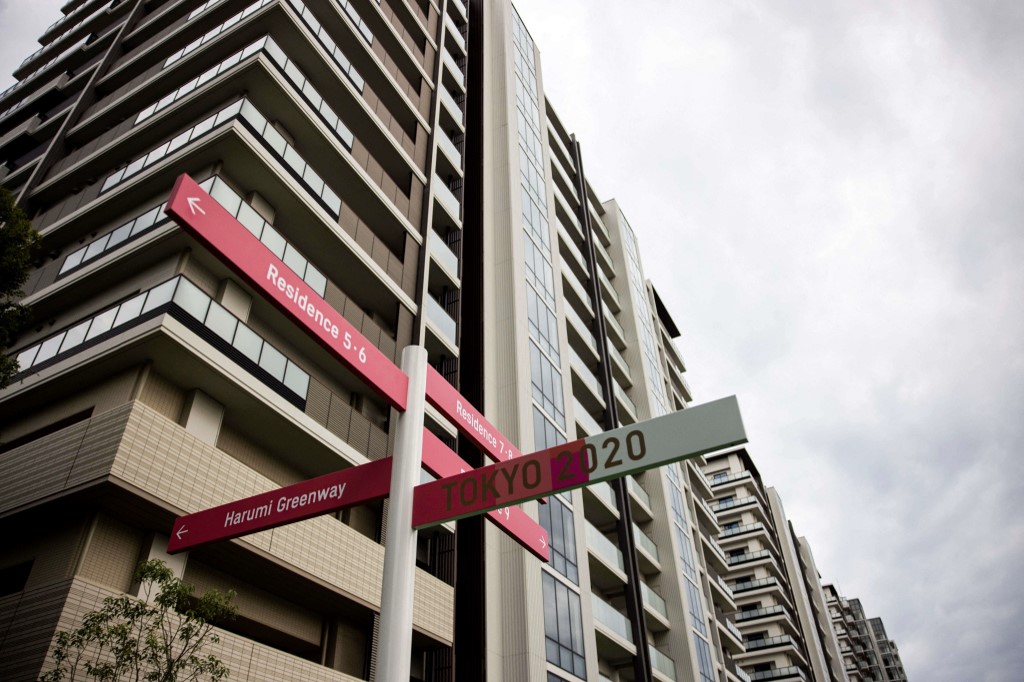
(FILES) This file photo taken on June 20, 2021 shows residential buildings of the Olympic Village behind road signs during a media tour of the Tokyo 2020 Olympic and Paralympic Village in Tokyo. (Photo by Behrouz MEHRI / AFP) /
For athletes competing at the Tokyo Games, the Olympic Village will be almost all they see, with strict coronavirus rules preventing them from leaving the compound except to train and compete.
Their stay in the village will also be shorter than usual: competitors can only arrive five days before their event, and must leave within 48 hours of winning or losing.
Here’s what a typical day might look like at Tokyo 2020’s waterside mini-city:
6:30am
(FILES) This file photo taken on June 20, 2021 shows recyclable cardboard beds and mattresses for athletes during a media tour at the Olympic and Paralympic Village for the Tokyo 2020 Games in Tokyo. (Photo by Akio KON / POOL / AFP)
The village is built to sleep up to 18,000 Olympians, coaches and officials. They should wake up refreshed, despite Tokyo’s 4:40am sunrise, thanks to thick black-out curtains.
As in many Japanese homes, space is limited, however — single rooms measure just nine square meters (100 square feet), and doubles 12 square meters.
The beds and partition walls are made from sturdy recyclable cardboard, to be cleared away after the Games when the 21 towers are turned into luxury homes. Perhaps not so good if your neighbor snores, however…
7:00am
Time for a daily coronavirus test — a requirement for everyone staying in the village. They will administer the saliva antigen tests themselves and then submit them for processing.
A positive result and a second positive on a more accurate PCR test means a trip to the fever clinic, a small prefab building in the center of the village.
At the clinic, a third test determines if you are out of the Games and need to isolate or go to hospital.
7:30am
(FILES) This file photo taken on June 20, 2021 shows a view of the main dining hall of the Olympic Village during a media tour of the Tokyo 2020 Olympic and Paralympic Village in Tokyo. (Photo by Behrouz MEHRI / AFP)
Forgetting to wear a mask can be easy, especially early in the morning — but they are mandatory in the village, except when sleeping and eating.
On the way to get breakfast, athletes can check an app that shows how crowded communal areas are, including the two floors of the vast 3,000-seat canteen.
8:00am
(FILES) This file photo taken on June 20, 2021 shows a view of the main dining hall of the Olympic Village during a media tour of the Tokyo 2020 Olympic and Paralympic Village in Tokyo. (Photo by Behrouz MEHRI / AFP) /
Village residents are asked to eat alone to avoid spreading potentially contagious droplets. Each seat is screened off with plexiglass.
There’s an immense selection of food, with traditional Japanese cuisine highlighted. Just about every dietary preference is catered to — vegetarian, halal, gluten-free — with nutritional values clearly indicated.
9:00am
(FILES) In this file photo taken on June 20, 2021, weightlifting equipment is seen at the fitness center during a media tour of the Tokyo 2020 Olympic and Paralympic Village in Tokyo. (Photo by Behrouz MEHRI / AFP)
The world’s top sportsmen and women can train at a huge gym with 600 cardio and weight-training machines.
Masks are mandatory even when getting sweaty, and even though the gym machines are cleaned frequently, users are recommended to disinfect them before they start.
11:00am
Public transport and walks outside the village are forbidden, so athletes must take dedicated buses from the site — built on reclaimed land in Tokyo Bay — to competition venues or training centers.
5:00pm
On their return to the village, Olympic teams can stop off at the “Village Plaza,” a wooden annex incorporating traditional Japanese construction techniques.
Inside are ATMs, cleaning services, a hairdresser and a cafe, among other conveniences — giving athletes the chance to buy a souvenir, even though sightseeing is off the cards.
7:00pm
(FILES) In this file photo taken on June 20, 2021, autonomous electric vehicles, which will be used at the Olympic Village, are seen during a media tour of the Tokyo 2020 Olympic and Paralympic Village in Tokyo. (Photo by Behrouz MEHRI / AFP)
It’s getting dark already. Back at the village, tired athletes can take one of the 17 self-driving shuttles, which circulate the site 24 hours a day, back to their block.
Each one can seat 19 passengers and there’s a human operator on board just in case.
8:00pm
https://twitter.com/tokyo2020/status/1414910086494007296?s=21
After dinner, athletes aren’t obliged to stay cooped up in their rooms. The Village recreation center beckons, with Nintendo consoles and spaces to relax, or they can wander around the waterside park.
Having a post-dinner beer al fresco isn’t an option, though, as alcohol is forbidden in groups and in public areas.
Violations of any rules will be punished, organizers have said — with disqualification from the Games a possibility.
10:00pm
Competitors aren’t allowed to bring family members with them to the Games. But before bed, they can chat with loved ones back home using free wifi.